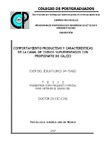Comportamiento productivo y características de la canal de ovinos suplementados con propionato de calcio.
Abstract
El objetivo del presente estudio fue evaluar el efecto de la inclusión propionato de calcio (PCa) en el rendimiento productivo, rendimiento en canal y costos de producción. Se usaron 24 ovinos dorper*pelibuey (peso inicial 27± 2 kg) distribuidos bajo un diseño completamente al azar con tres tratamientos: 0, 1 y 2 % de PCa kg-1 alimento (n=8), durante 42 días. Hubo diferencias en consumo de materia seca (CMS), ganancia diaria de peso (GDP), conversión alimenticia (CA), rendimiento en canal caliente (RCC) y fría (RCF) por la inclusión de PropCa (P <0.05). No hubo diferencias en Grasa dorsal (GD), área de chuleta (ACh), peso vivo al sacrificio (PVS), peso de canal caliente (PCC) y fría (PCF). Se realizó un segundo trabajo para evaluar el efecto del PCa en glucosa en plasma, fermentación ruminal y digestibilidad de MS, FDN y FDA del alimento en seis novillos Holstein (380 ±20 kg de peso vivo) con cánula ruminal permanente, en un diseño de cuadrado latino 3x3 replicado. Los tratamientos fueron: T0 (0g), T1 (100g) y T2 (200g) de PCa animal-1d-1. El CMS, se restringió a 10 kg animal-1d-1. El nivel de PCa en la dieta modifico el nivel de glucosa en plasma (P˃0.05). Las dietas con mayor nivel de PCa condujeron a una menor proporción molar de acetato y mayores de propionato en rumen (P<0.05). No hubo efecto en N-NH3 y pH ruminal por la suplementación con PCa. La cinética de digestión ruminal in situ de MS, FDN y FDA, no presentaron diferencias al incluir PCa en las dietas. La inclusión de PropCa en dietas para ovinos mejora el rendimiento productivo y de la canal. No hubo diferencias en el pH, N-NH3 y la cinética de digestión del alimento, ni en la DISMS, DISFDN o DISFDA; sin embargo, la concentración de glucosa en plasma y propionato en rumen se incrementaron debido a la suplementación con PCa en la dieta y no por una modificación en la fermentación ruminal. _______________ PRODUCTIVE BEHAVIOR AND CARCASS CHARACTERISTICS OF THE SHEEP SUPPLEMENTED WITH CALCIUM PROPIONATE. ABSTRACT: The objective of the present study was to evaluate the effect of the inclusion of calcium propionate (PCa) in the productive performance, channel yield and production costs. Twenty-four dorper * pelibuey sheep (initial weight 27 ± 2 kg) distributed under a completely randomized design were used with three treatments: 0, 1 and 2% of PCa kg-1 food (n = 8), for 42 days. There were differences in dry matter consumption (CMS), daily weight gain (GDP), feed conversion (CA), hot runner yield (RCC) and cold (RCF) due to the inclusion of PropCa (P <0.05). There were no differences in dorsal fat (GD), chop area (ACh), live weight at slaughter (PVS), and hot carcass weight (PCC) and cold (PCF). A second work was carried out to evaluate the effect of PCa on plasma glucose, ruminal fermentation and digestibility of MS, NDF and ADF of the food in six Holstein steers (380 ± 20 kg live weight) with permanent ruminal cannula, in a design of 3x3 Latin square replicated. The treatments were: T0 (0g), T1 (100g) and T2 (200g) of PCa animal-1d-1. The CMS was restricted to 10 kg animal-1d-1. The level of PCa in the diet modified the plasma glucose level (P˃0.05). Diets with a higher level of PCa led to a lower molar ratio of acetate and higher proportions of rumen propionate (P <0.05). There was no effect on N-NH3 and ruminal pH due to PCa supplementation. The kinetics of in situ ruminal digestion of MS, NDF and ADF did not differ when PCa was included in the diets. The inclusion of PropCa in sheep diets improves the productive performance and the carcass. There were no differences in the pH, N-NH3 and the kinetics of digestion of the food, nor in the DISMS, DISFDN or DISFDA; however, the concentration of plasma glucose and propionate in the rumen increased due to PCa supplementation in the diet and not due to a modification in ruminal fermentation.
Collections
- Tesis MC, MT, MP y DC [403]


